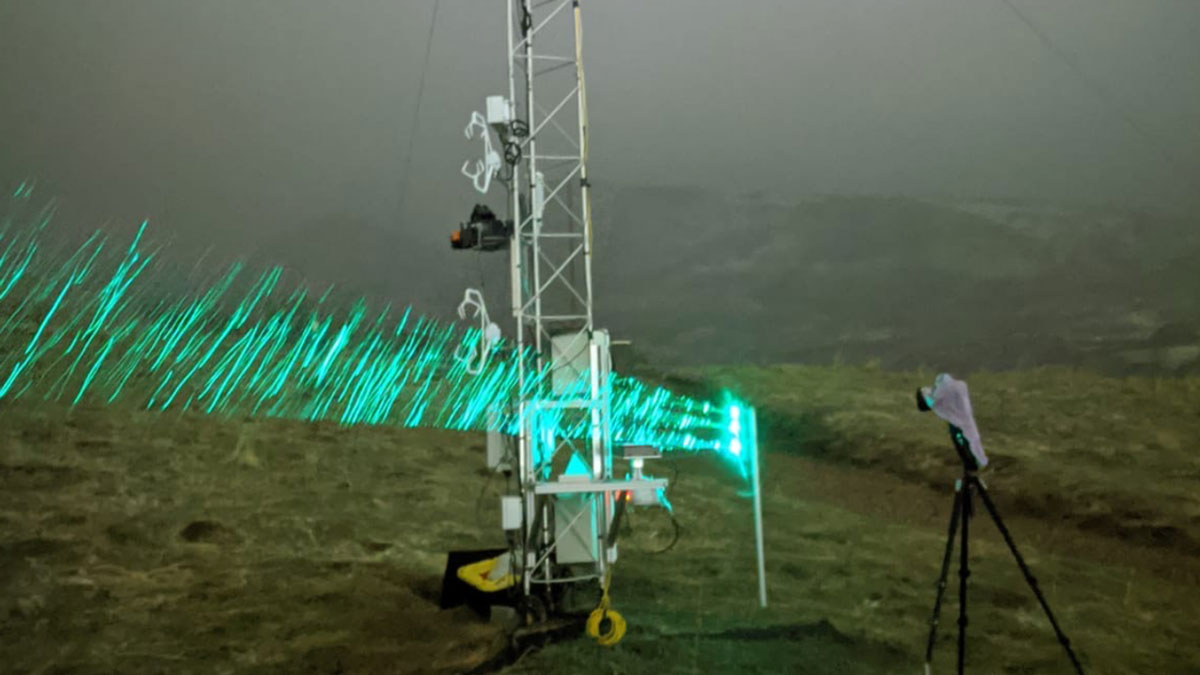Snowflakes take many routes from cloud to ground. Large, soft flakes swirl and tumble gently from above. Sharp, painful bits of ice get spit from the sky in a sideways burst. Mushy, wet snow falls in clumps. The ways in which snow travels through the air seem nothing short of complicated.
But a new study published in Physics of Fluids showed that predicting how fast a snowflake moves might be a lot simpler than previously thought. That could help make weather predictions more accurate, as well as reveal information about precipitation in a changing climate.
“It dawned on me that all our weather and climate models assume that snowflakes fall as still air. Clearly, they don’t.”
Needles, discs, spheres, cylinders, plates, graupel—snowflakes come in a multitude of shapes, influenced by temperature and atmospheric conditions. “The same snowflake may fall at different speeds, depending on the wind or the turbulence,” said Michele Guala, a fluid mechanics expert at the University of Minnesota who was not involved in the new study.
Tim Garrett, an atmospheric scientist and one of the authors of the study, has been researching the physics of snow for 15 years. “It dawned on me that all our weather and climate models assume that snowflakes fall as still air. Clearly, they don’t,” he said. “Rain may fall almost straight down, but snowflakes are clearly a swirl. Even though this is right in front of our eyes, for some reason, it’s not part of any weather or climate model.”
Garrett and his colleagues built a device to study how snowflakes fall that could measure a flake’s mass and density—something that had never been done before. They crafted the Differential Emissivity Imaging Disdrometer (DEID), which uses a camera and a laser light sheet to track snowflakes and capture them as they fall into a metal tray. “The device is very simple: a frying pan and a camera,” Garrett said.
The researchers set up the DEID in Utah’s Alta ski area in the winter of 2021–2022, when the mountainous region experienced record snowfall. They snapped shots of more than 500,000 snowflakes and recorded air temperature, relative humidity, and turbulence in the surrounding atmosphere.
“I always get excited about the tools that people use for clever measurement techniques. And this one is particularly interesting,” said Raymond Shaw, a physicist at Michigan Technological University. It’s “surprisingly difficult” to measure mass and size simultaneously, and record how fast the flake is falling, he said.
Simplicity in the Snowflakes
It’s hard enough to photograph a single snowflake before it melts, and tracking one flake’s trajectory from cloud to ground has proven elusive for many reasons. For one, snowflakes may weigh only a hundredth of a milligram. Turbulence in the atmosphere also creates conditions too messy to track a tiny piece of frozen precipitation falling from the sky.
Trying to re-create a snowstorm in a laboratory setting is not ideal for gathering the information needed to understand how snowflakes move in the chaotic real world. Outdoors, air moves up and down, but also sideways—that turbulence affects the meandering path a flake of snow takes.
“What was unexpected was how remarkably predictable the relationships were.”
The DEID takes a video of falling snowflakes, allowing motion tracking software to calculate the velocities and acceleration of individual flakes.
The researchers were able to predict the snowflakes’ acceleration using the Stokes number, an equation describing how particles move in a fluid. The Stokes number compares how quickly a particle reaches it terminal velocity—determined from its mass, density, and size—to how fast the air’s smallest turbulent swirls are rotating. The researchers measured turbulence with a separate device, a 3D sonic anemometer.
Snowflakes falling in high turbulence had higher average acceleration. That’s expected, Garrett said. “What was unexpected was how remarkably predictable the relationships were, not just for the average, but for how likely it was to see any individual snowflake’s acceleration.”
What Speed Can Say
The finding could pave the way for other scientists to create mathematical equations to solve seemingly complex questions about snow, such as how to better forecast the weather, and study how precipitation conditions may shift due to climate change.
More energy in the atmosphere may lead to more turbulence, Garrett said. None of the current climate models take snowflake speed into account. “That is important, because how fast a snowflake falls affects things like the lifetime of clouds,” he said. Even in warm, tropical regions, precipitation begins high in the atmosphere as snow. Under warmer conditions, precipitation might also change from the big, floppy snowflakes that fall slowly into raindrops that fall quickly.
“The authors measured everything that has to be measured to improve the current modeling of settling velocity,” Guala said. Still, they need to test the finding in other snowy locations. The rugged mountains of Utah might have very different snowflake movement than the flat plains of Minnesota, for instance. “It would be great to see other sites, other measurements, other instruments,” Guala said. “Claims of universality are always challenging—especially for something that is difficult to measure exactly. In fluid mechanics, there are very few behaviors that are universal.”
—Rebecca Owen (@beccapox), Science Writer

